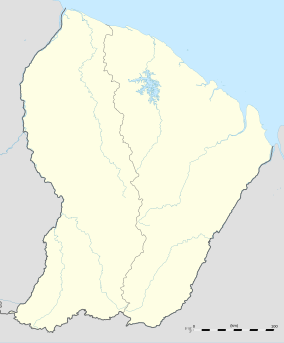Amana Nature Reserve
| Amana Nature Reserve | |
|---|---|
IUCN category IV (habitat/species management area) | |
 | |
 | |
| Location | French Guiana, France |
| Nearest city | Awala-Yalimapo |
| Coordinates | 5°44′30″N 53°53′34″W / 5.7417°N 53.8927°WCoordinates: 5°44′30″N 53°53′34″W / 5.7417°N 53.8927°W |
| Area | 148 km2 (57 sq mi)[1] |
| Established | 13 March 1998[1] |
| Governing body | |
| Website | Reserves-Naturelles.org (in French) |
The Amana Nature Reserve (French: Réserve naturelle nationale de l'Amana) is a nature reserve in French Guiana, France.[2] It has been protected, because it is one of the world's largest leatherback turtle nesting site.[3][4] It is part of the communes of Awala-Yalimapo and Mana.[1]
Overview[]
The nature reserve stretches from the Maroni to the . The reserve consists of beaches, mangrove forests, swamps and savannahs.[2]

Leatherback Sea Turtles need very specific nesting beaches, and return to the same beach every two to three years. It is an vulnerable species with a limited number of suitable beaches.[5] The neighbouring Wia Wia Nature Reserve in Suriname was used by the turtles as well until the beach shifted resulting in the disappearance of the turtles.[6]
The beaches at Amana were home to 5,029 to 63,294 nests between 1967 and 2005.[5] The turtles lay their eggs between March to July, dig a hole which will contain 80 to 90 eggs. The hole is located between the high water mark and the vegetation. The baby turtles will emerge about two months later.[7]
Other turtles who use the beach are the Green sea turtle, the Olive ridley sea turtle and occasionally the Hawksbill sea turtle.[2]
References[]
- ^ Jump up to: a b c "L'Amana". Inventaire National du Patrimoine Naturel (in French). Retrieved 15 March 2021.
- ^ Jump up to: a b c "Amana". Reserves Naturelles (in French). Retrieved 15 March 2021.
- ^ "Mana, précurseurse depuis toujours". Le Jour du Seigneur (in French). Retrieved 15 March 2021.
- ^ Sabrina Fossettea (2008). "The world's largest leatherback rookeries: A review of conservation-oriented research in French Guiana/Suriname and Gabon". Journal of Experimental Marine Biology and Ecology. Volume 356, Issues 1–2. doi:10.1016/j.jembe.2007.12.024.
|volume=has extra text (help) - ^ Jump up to: a b "Leatherback Sea Turtle (Dermochelys coriacea)". North Florida Ecological Services Office. Retrieved 15 March 2021.
- ^ Ouboter, Paul E. (2001). "Directory of protected areas of Suriname". IBER. p. 11.
- ^ Alexandra Maros (2006). "Evidence of the exploitation of marine resource by the terrestrial insect Scapteriscus didactylus through stable isotope analyzes of its cuticle". BMC Ecology. 6. doi:10.1186/1472-6785-6-6.
External links[]
- Official website (in French)
- IUCN Category IV
- Beaches of French Guiana
- Environment of French Guiana
- Mana, French Guiana
- Nature reserves in France
- Protected areas of French Guiana
- French Guiana geography stubs
- South American protected area stubs
